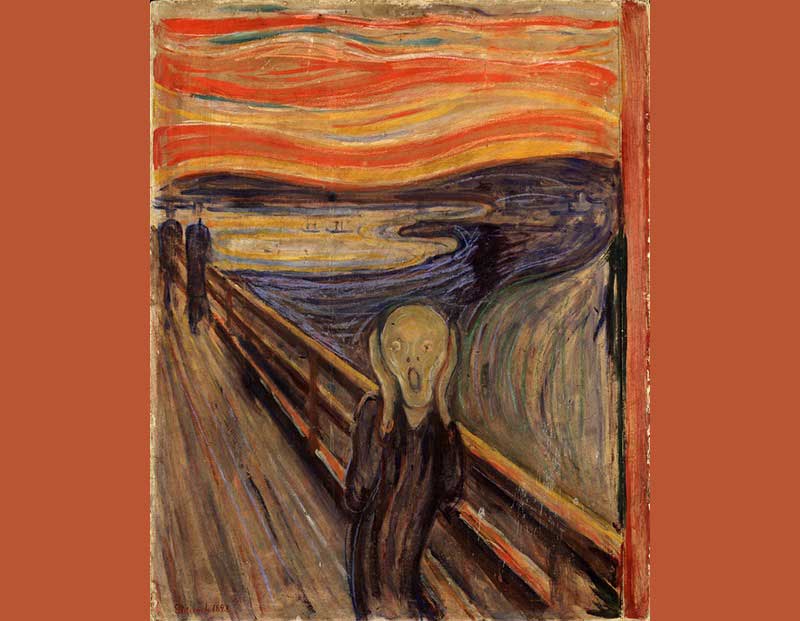
The Scream, created by Norwegian Expressionist artist Edvard Munch, and illustrating a tormented cry translated into waves of color that resonate across the landscape, is probably the most iconic human figure in the history of Western art. With skull-shaped head, elongated hands, wide eyes, flaring nostrils and egg-shaped mouth, in the background of the swirling blue landscape and especially the fiery orange and yellow sky, have given birth to numerous theories regarding the scene. It illustrates a tormented cry translated into waves of colour that resonate across the landscape.
The Scream, created in 1893, is essentially autobiographical, an expressionistic construction based on the artist’s experience of a scream piercing through nature while he was on a walk, and he painted it to represent his soul using an unrealistic style to paint his emotions.
According to Munch, he was walking down a road similar to the one in the painting, while the sun was setting, creating a beautiful, vibrant background. His friends were walking with him, but he stopped as he looked at the sky, while his friends continued walking. Suddenly he felt tired and claustrophobic, became anxious as he felt if the weight of nature, along with that of the world, came down on him all at once. Munch explained that he painted that moment of his existential crisis, which is considered to be a panic attack, a normal thing for many people, and most will experience at least once in their lives. However, Munch rendered his feelings of the panic moment in the painting in such a style, which if pushed to extremes can destroy human integrity.

The sound of the scream must have been heard by Munch at a time when his mind was in an abnormal state. His panic attack was mixed with an existential crisis. His past was incredibly traumatic, which likely contributed to both his existential crisis and the idea to go through with painting. Before his breakdown, one of his sisters was committed to a mental asylum due to her severe mental health issues. In addition to that, Munch was struggling with the loss of his mother at five years old and one of his loving sisters when he was around thirteen. As a child, he suffered from health issues, missed a lot of schools, and the issues even caused him to be unable to go outside in the winters.
His father was verbally abusive, and later in his life, he suffered more abuse by his father as he disliked Munch’s career. His early works were also the subject of sharp criticism by the general public. Therefore, it is evident that the trauma of his childhood inflicted many mental health issues on him, and the continued abuse and stress of his career certainly went against him.

However, the Scream was not simply a product of stress or an unusual and sporadic moment of panic. It is a recognizable symbol of anxiety and alienation, and it represents the darkly troubled times Munch was experiencing as he was trying hard to deal with his mental illness and trauma, and his attempt to rationalize and explain his experience through what he knew the best, which is painting.
In the Scream, Munch allowed the foreground figure to become distorted by the flow of nature to depict his own morbid experience, while the scream could be interpreted as expressing the agony of the obliteration of human personality frozen in a perpetual scream of horror. Significantly, although it was Munch himself who underwent the experience depicted, the protagonist bears no resemblance to him or anyone else, as the creature in the foreground has been depersonalized and sexually ambiguous.

The Scream is surprisingly a simple work, in which Edvard Munch used a minimum number of forms to achieve maximum expressiveness. The canvas depicts three main areas that include the bridge, extended at a steep angle from the middle distance at the left to fill the foreground; a landscape of shoreline, lake or fjord, and hills; and the sky, represented by curving lines in tones of unnatural orange, yellow, red, and blue-green. The foreground and background are blended into one another, while the lyrical lines of the hills ripple through the sky. However, the human figures are starkly separated from the landscape by the uncanny bridge that provides a sharp contrast with the shapes of the landscape and the sky. The two faceless and shapeless figures in the background belong to the geometric precision of the bridge, while the lines of the body, hands and head of the foreground figure take up the same curving shapes that dominate the background of the landscape.

The Scream exists in four forms: the first painting, done in oil, tempera, and pastel on cardboard in1893 is exhibited at the National Gallery of Art, Oslo. Of the two pastel versions, one is housed at the Munch Museum, Oslo and the other is in a private collection. The final tempera painting is also with the National Gallery of Art, Oslo. Apart from that Munch also created a lithographic version of the Scream in 1895.

In 1994, the thieves broke in through a window of the National Gallery in Oslo and stole the Scream, which was luckily recovered within three months. Later, in 2004, a gang of gunmen broke into the Munch Museum, stealing a different version of The Scream, along with the artist’s Madonna. The paintings remained missing until 2006, before they were recovered.